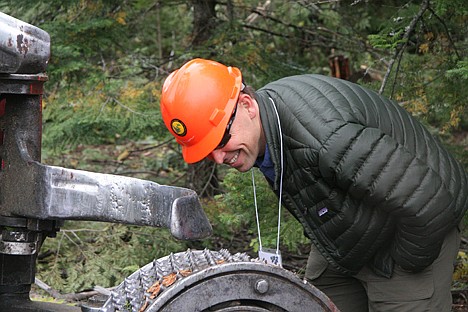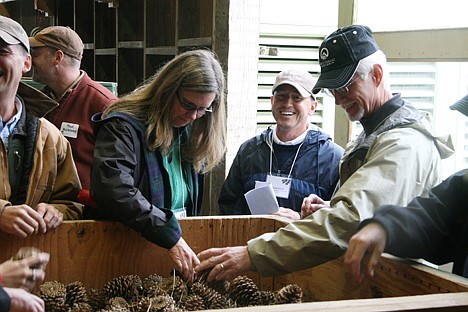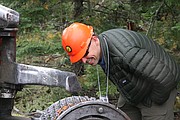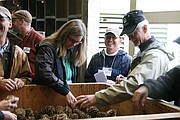Timber Technology
Nick Rotunno | Hagadone News Network | UPDATED 15 years, 3 months AGO
Like a futuristic dinosaur, the hydraulic harvester rumbled slowly forward, crunching branches and boughs beneath its massive treads.
It swung to the right and clamped on to a good-sized tree. Severing the trunk with one swift buzz of its chain saw, the harvester turned the whole tree sideways, chomping and grinding with big metal teeth, ripping away the extra limbs until there was only a clean, straight log, like the mast of a sailing ship. Then it sawed the log into separate pieces, tossed them aside and roared on, quickly grabbing another tree and repeating the process.
One spectator said it looked like a machine from "Avatar," the recent science-fiction blockbuster. Others remarked on the engineering, the efficiency, the modernity of such a high-powered contraption, and all were visibly impressed.
Operated by Mike Reynolds Logging, the harvester worked on private timberland southwest of Priest River, a few miles from Highway 41. The Miracle at Work Forest Tour, hosted by the Idaho Forest Products Commission, visited the site on Friday afternoon. A mix of woodsmen, foresters, scientists and academics, the tour group witnessed firsthand what high-tech logging machinery can do.
"Overall, (the tour) was very educational, (I) learned a lot, and I saw some things that I've never seen before that I appreciated seeing," said Jay Lee, vice president for instruction at North Idaho College. "My image of the lumber worker was the more traditional stuff I grew up with."
The logging demonstration was just one brief stop on the two-day tour, which began Thursday at the Red Lion Templin's Resort in Post Falls. With a host of destinations, speakers and subjects, the Miracle at Work Tour offered a snapshot of Idaho's forested lands - the timber products they provide, the dangers that threaten them on a daily basis, and what the future might bring.
"I think these types of tours are incredibly beneficial," said Laurie Boeckel, legislative vice president of the Idaho PTA, whose primary focus is state endowment lands. "For me, the most insightful thing as an advocate is knowing there are so many issues our agencies and elected officials face."
Embarking bright and early Thursday morning, the participants toured Chilco Sawmill, bused up to Farragut State Park and stopped at the Funk Tree Farm in the Wolf Lodge area. Along the way, they learned about Idaho's wood products, forest management, wildlife, firefighting, water quality and private woodland ownership. The tour also traveled to Mason Saddle, Fourth of July Pass and a particleboard plant in Post Falls, Plummer Forest Products.
At Chilco and in Post Falls, Boeckel found the modern methods of lumber production fascinating.
"To learn how technology is so critical in keeping mills competitive ... it definitely was a firsthand way of seeing the challenges that other mills that don't keep up with technology are going to face," she said. "The tours of those mills - that was very, very impressive. It's good for people to see how technology impacts not just new jobs, but jobs that have been around in an industry for hundreds of years."
Day 2 was equally packed, with a 6:45 a.m. wakeup call and a long trek through the North Idaho panhandle. The group listened to a pair of lectures, heard Frank Buell - owner of Jack Buell Trucking in St. Maries, a company with 217 full-time employees - talk about hauling biomass and other forest freight, and looked on as Reid Ahlf discussed the services of his company, ABCO Wood Recycling.
Wandering the U.S. Forest Service nursery in Coeur d'Alene, a 50-year-old facility, the participants saw how seeds are removed from pine cones, frozen and later planted. After a trip to Priest River country, where the fearsome harvester sawed and snorted, and one more stop at another logging operation near Twin Lakes, the tour headed for home.
David New, president of Growing Excellence in Boise, addressed the future of Idaho's forests and the quality of local timber. As the cost of energy rises, he said, manufacturers will turn to wood products instead of steel, because lumber is less expensive to produce.
"The economy doesn't grow unless the manufacturing base grows," New said. "This is some of the most productive workforce in the world. Exports are going to be an important part of Idaho's and the Inland Northwest's future. I think buying and investing locally matters, and it matters big time."
According to data provided by the Idaho Forest Products Commission, forests cover 40.5 percent of the state. Idaho forests grow 1 billion cubic feet of wood annually; the timber industry harvests 246 million cubic feet every year.
But many trees are dying, the commission noted - 330 million cubic feet every 12 months, the result of disease, wildfire and the natural forest cycle.
"People have different opinions about what we ought to do with forests," said Dr. Jay O'Laughlin of the University of Idaho, who spoke early Friday. "Forests will play a part in growing our economy. We're dependent on the (timber) industry to a great extent."
As the tour wound down, Jay Lee expressed hope. He had seen the mills, the forests, the logging outfits and the tree-growers. He had listened carefully.
"I think I am optimistic," Lee said. "If we do things right, I think we can go nowhere but up."
ARTICLES BY NICK ROTUNNO

Together they're stronger
Hayden military family earns national honor
The cavernous conference room at the Marriott Hotel in Washington, D.C., was packed with people.

Fun in the sun in Cd'A
Vendors descend on downtown for trio of summer events
COEUR d'ALENE - Carli Osika is 15 years old, but on Friday afternoon she didn't sing like a teenager.
Two state bills target fish, game rules
State lawmakers are considering bills that would eliminate the motorized vehicle hunting rule (MVR) in all Idaho Department of Fish and Game units and limit the rule-making powers of the IDFG Commission.





